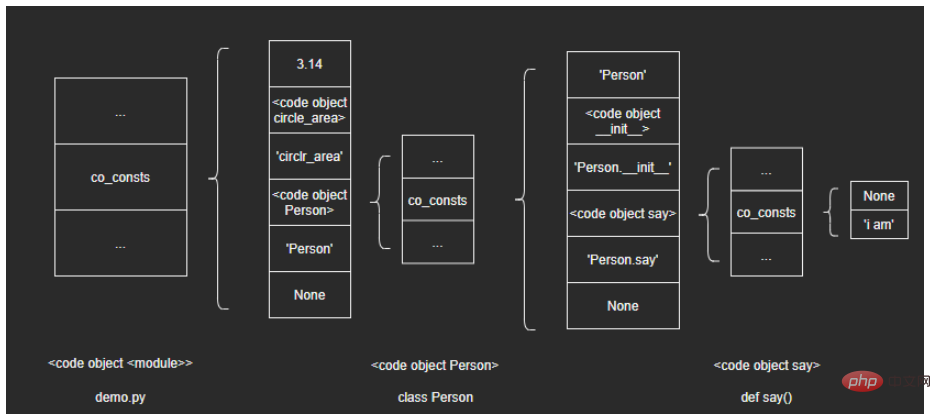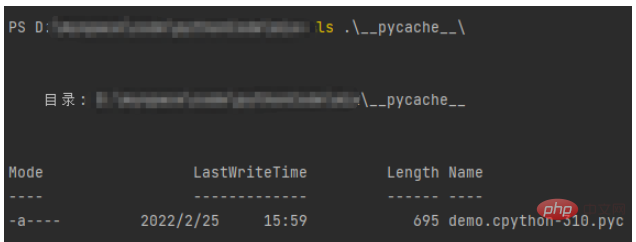问题:
我们每天都要编写一些Python程序,或者用来处理一些文本,或者是做一些系统管理工作。程序写好后,只需要敲下python命令,便可将程序启动起来并开始执行:
$ python some-program.py
那么,一个文本形式的.py文件,是如何一步步转换为能够被CPU执行的机器指令的呢?此外,程序执行过程中可能会有.pyc文件生成,这些文件又有什么作用呢?
1. 执行过程
虽然从行为上看Python更像Shell脚本这样的解释性语言,但实际上Python程序执行原理本质上跟Java或者C#一样,都可以归纳为虚拟机和字节码。Python执行程序分为两步:先将程序代码编译成字节码,然后启动虚拟机执行字节码:

虽然Python命令也叫做Python解释器,但跟其他脚本语言解释器有本质区别。实际上,Python解释器包含编译器以及虚拟机两部分。当Python解释器启动后,主要执行以下两个步骤:
编译器将.py文件中的Python源码编译成字节码虚拟机逐行执行编译器生成的字节码
因此,.py文件中的Python语句并没有直接转换成机器指令,而是转换成Python字节码。
2. 字节码
Python程序的编译结果是字节码,里面有很多关于Python运行的相关内容。因此,不管是为了更深入理解Python虚拟机运行机制,还是为了调优Python程序运行效率,字节码都是关键内容。那么,Python字节码到底长啥样呢?我们如何才能获得一个Python程序的字节码呢——Python提供了一个内置函数compile用于即时编译源码。我们只需将待编译源码作为参数调用compile函数,即可获得源码的编译结果。
3. 源码编译
下面,我们通过compile函数来编译一个程序:
源码保存在demo.py文件中:
PI = 3.14
def circle_area(r):
return PI * r ** 2
class Person(object):
def __init__(self, name):
self.name = name
def say(self):
print('i am', self.name)编译之前需要将源码从文件中读取出来:
>>> text = open('D:\myspace\code\pythonCode\mix\demo.py').read()
>>> print(text)
PI = 3.14
def circle_area(r):
return PI * r ** 2
class Person(object):
def __init__(self, name):
self.name = name
def say(self):
print('i am', self.name)然后调用compile函数来编译源码:
>>> result = compile(text,'D:\myspace\code\pythonCode\mix\demo.py', 'exec')
compile函数必填的参数有3个:
source:待编译源码
filename:源码所在文件名
mode:编译模式,exec表示将源码当作一个模块来编译
三种编译模式:
exec:用于编译模块源码
single:用于编译一个单独的Python语句(交互式下)
eval:用于编译一个eval表达式
4. PyCodeObject
通过compile函数,我们获得了最后的源码编译结果result:
>>> result <code object <module> at 0x000001DEC2FCF680, file "D:\myspace\code\pythonCode\mix\demo.py", line 1> >>> result.__class__ <class 'code'>
最终我们得到了一个code类型的对象,它对应的底层结构体是PyCodeObject
PyCodeObject源码如下:
/* Bytecode object */
struct PyCodeObject {
PyObject_HEAD
int co_argcount; /* #arguments, except *args */
int co_posonlyargcount; /* #positional only arguments */
int co_kwonlyargcount; /* #keyword only arguments */
int co_nlocals; /* #local variables */
int co_stacksize; /* #entries needed for evaluation stack */
int co_flags; /* CO_..., see below */
int co_firstlineno; /* first source line number */
PyObject *co_code; /* instruction opcodes */
PyObject *co_consts; /* list (constants used) */
PyObject *co_names; /* list of strings (names used) */
PyObject *co_varnames; /* tuple of strings (local variable names) */
PyObject *co_freevars; /* tuple of strings (free variable names) */
PyObject *co_cellvars; /* tuple of strings (cell variable names) */
/* The rest aren't used in either hash or comparisons, except for co_name,
used in both. This is done to preserve the name and line number
for tracebacks and debuggers; otherwise, constant de-duplication
would collapse identical functions/lambdas defined on different lines.
*/
Py_ssize_t *co_cell2arg; /* Maps cell vars which are arguments. */
PyObject *co_filename; /* unicode (where it was loaded from) */
PyObject *co_name; /* unicode (name, for reference) */
PyObject *co_linetable; /* string (encoding addr<->lineno mapping) See
Objects/lnotab_notes.txt for details. */
void *co_zombieframe; /* for optimization only (see frameobject.c) */
PyObject *co_weakreflist; /* to support weakrefs to code objects */
/* Scratch space for extra data relating to the code object.
Type is a void* to keep the format private in codeobject.c to force
people to go through the proper APIs. */
void *co_extra;
/* Per opcodes just-in-time cache
*
* To reduce cache size, we use indirect mapping from opcode index to
* cache object:
* cache = co_opcache[co_opcache_map[next_instr - first_instr] - 1]
*/
// co_opcache_map is indexed by (next_instr - first_instr).
// * 0 means there is no cache for this opcode.
// * n > 0 means there is cache in co_opcache[n-1].
unsigned char *co_opcache_map;
_PyOpcache *co_opcache;
int co_opcache_flag; // used to determine when create a cache.
unsigned char co_opcache_size; // length of co_opcache.
};代码对象PyCodeObject用于存储编译结果,包括字节码以及代码涉及的常量、名字等等。关键字段包括:
| 字段 | 用途 |
|---|---|
| co_argcount | 参数个数 |
| co_kwonlyargcount | 关键字参数个数 |
| co_nlocals | 局部变量个数 |
| co_stacksize | 执行代码所需栈空间 |
| co_flags | 标识 |
| co_firstlineno | 代码块首行行号 |
| co_code | 指令操作码,即字节码 |
| co_consts | 常量列表 |
| co_names | 名字列表 |
| co_varnames | 局部变量名列表 |
下面打印看一下这些字段对应的数据:
通过co_code字段获得字节码:
>>> result.co_code b'd\x00Z\x00d\x01d\x02\x84\x00Z\x01G\x00d\x03d\x04\x84\x00d\x04e\x02\x83\x03Z\x03d\x05S\x00'
通过co_names字段获得代码对象涉及的所有名字:
>>> result.co_names ('PI', 'circle_area', 'object', 'Person')
通过co_consts字段获得代码对象涉及的所有常量:
>>> result.co_consts (3.14, <code object circle_area at 0x0000023D04D3F310, file "D:\myspace\code\pythonCode\mix\demo.py", line 3>, 'circle_area', <code object Person at 0x0000023D04D3F5D0, file "D:\myspace\code\pythonCode\mix\demo.py", line 6>, 'Person', None)
可以看到,常量列表中还有两个代码对象,其中一个是circle_area函数体,另一个是Person类定义体。对应Python中作用域的划分方式,可以自然联想到:每个作用域对应一个代码对象。如果这个假设成立,那么Person代码对象的常量列表中应该还包括两个代码对象:init函数体和say函数体。下面取出Person类代码对象来看一下:
>>> person_code = result.co_consts[3] >>> person_code <code object Person at 0x0000023D04D3F5D0, file "D:\myspace\code\pythonCode\mix\demo.py", line 6> >>> person_code.co_consts ('Person', <code object __init__ at 0x0000023D04D3F470, file "D:\myspace\code\pythonCode\mix\demo.py", line 7>, 'Person.__init__', <code object say at 0x0000023D04D3F520, file "D:\myspace\code\pythonCode\mix\demo.py", line 10>, 'Person.say', None)
因此,我们得出结论:Python源码编译后,每个作用域都对应着一个代码对象,子作用域代码对象位于父作用域代码对象的常量列表里,层级一一对应。

至此,我们对Python源码的编译结果——代码对象PyCodeObject有了最基本的认识,后续会在虚拟机、函数机制、类机制中进一步学习。
5. 反编译
字节码是一串不可读的字节序列,跟二进制机器码一样。如果想读懂机器码,可以将其反汇编,那么字节码可以反编译吗?
通过dis模块可以将字节码反编译:
>>> import dis >>> dis.dis(result.co_code) 0 LOAD_CONST 0 (0) 2 STORE_NAME 0 (0) 4 LOAD_CONST 1 (1) 6 LOAD_CONST 2 (2) 8 MAKE_FUNCTION 0 10 STORE_NAME 1 (1) 12 LOAD_BUILD_CLASS 14 LOAD_CONST 3 (3) 16 LOAD_CONST 4 (4) 18 MAKE_FUNCTION 0 20 LOAD_CONST 4 (4) 22 LOAD_NAME 2 (2) 24 CALL_FUNCTION 3 26 STORE_NAME 3 (3) 28 LOAD_CONST 5 (5) 30 RETURN_VALUE
字节码反编译后的结果和汇编语言很类似。其中,第一列是字节码的偏移量,第二列是指令,第三列是操作数。以第一条字节码为例,LOAD_CONST指令将常量加载进栈,常量下标由操作数给出,而下标为0的常量是:
>>> result.co_consts[0]3.14
这样,第一条字节码的意义就明确了:将常量3.14加载到栈。
由于代码对象保存了字节码、常量、名字等上下文信息,因此直接对代码对象进行反编译可以得到更清晰的结果:
>>>dis.dis(result)
1 0 LOAD_CONST 0 (3.14)
2 STORE_NAME 0 (PI)
3 4 LOAD_CONST 1 (<code object circle_area at 0x0000023D04D3F310, file "D:\myspace\code\pythonCode\mix\demo.py", line 3>)
6 LOAD_CONST 2 ('circle_area')
8 MAKE_FUNCTION 0
10 STORE_NAME 1 (circle_area)
6 12 LOAD_BUILD_CLASS
14 LOAD_CONST 3 (<code object Person at 0x0000023D04D3F5D0, file "D:\myspace\code\pythonCode\mix\demo.py", line 6>)
16 LOAD_CONST 4 ('Person')
18 MAKE_FUNCTION 0
20 LOAD_CONST 4 ('Person')
22 LOAD_NAME 2 (object)
24 CALL_FUNCTION 3
26 STORE_NAME 3 (Person)
28 LOAD_CONST 5 (None)
30 RETURN_VALUE
Disassembly of <code object circle_area at 0x0000023D04D3F310, file "D:\myspace\code\pythonCode\mix\demo.py", line 3>:
4 0 LOAD_GLOBAL 0 (PI)
2 LOAD_FAST 0 (r)
4 LOAD_CONST 1 (2)
6 BINARY_POWER
8 BINARY_MULTIPLY
10 RETURN_VALUE
Disassembly of <code object Person at 0x0000023D04D3F5D0, file "D:\myspace\code\pythonCode\mix\demo.py", line 6>:
6 0 LOAD_NAME 0 (__name__)
2 STORE_NAME 1 (__module__)
4 LOAD_CONST 0 ('Person')
6 STORE_NAME 2 (__qualname__)
7 8 LOAD_CONST 1 (<code object __init__ at 0x0000023D04D3F470, file "D:\myspace\code\pythonCode\mix\demo.py", line 7>)
10 LOAD_CONST 2 ('Person.__init__')
12 MAKE_FUNCTION 0
14 STORE_NAME 3 (__init__)
10 16 LOAD_CONST 3 (<code object say at 0x0000023D04D3F520, file "D:\myspace\code\pythonCode\mix\demo.py", line 10>)
18 LOAD_CONST 4 ('Person.say')
20 MAKE_FUNCTION 0
22 STORE_NAME 4 (say)
24 LOAD_CONST 5 (None)
26 RETURN_VALUE
Disassembly of <code object __init__ at 0x0000023D04D3F470, file "D:\myspace\code\pythonCode\mix\demo.py", line 7>:
8 0 LOAD_FAST 1 (name)
2 LOAD_FAST 0 (self)
4 STORE_ATTR 0 (name)
6 LOAD_CONST 0 (None)
8 RETURN_VALUE
Disassembly of <code object say at 0x0000023D04D3F520, file "D:\myspace\code\pythonCode\mix\demo.py", line 10>:
11 0 LOAD_GLOBAL 0 (print)
2 LOAD_CONST 1 ('i am')
4 LOAD_FAST 0 (self)
6 LOAD_ATTR 1 (name)
8 CALL_FUNCTION 2
10 POP_TOP
12 LOAD_CONST 0 (None)
14 RETURN_VALUE操作数指定的常量或名字的实际值在旁边的括号内列出,此外,字节码以语句为单位进行了分组,中间以空行隔开,语句的行号在字节码前面给出。例如PI = 3.14这个语句就被会变成了两条字节码:
1 0 LOAD_CONST 0 (3.14)
2 STORE_NAME 0 (PI)6. pyc
如果将demo作为模块导入,Python将在demo.py文件所在目录下生成.pyc文件:
>>> import demo

pyc文件会保存经过序列化处理的代码对象PyCodeObject。这样一来,Python后续导入demo模块时,直接读取pyc文件并反序列化即可得到代码对象,避免了重复编译导致的开销。只有demo.py有新修改(时间戳比.pyc文件新),Python才会重新编译。
因此,对比Java而言:Python中的.py文件可以类比Java中的.java文件,都是源码文件;而.pyc文件可以类比.class文件,都是编译结果。只不过Java程序需要先用编译器javac命令来编译,再用虚拟机java命令来执行;而Python解释器把这两个过程都完成了。
以上是Python程序的执行过程包括将源代码转换为字节码(即编译)以及执行字节码的详细内容。更多信息请关注PHP中文网其他相关文章!
 Python的科学计算中如何使用阵列?Apr 25, 2025 am 12:28 AM
Python的科学计算中如何使用阵列?Apr 25, 2025 am 12:28 AMArraysinpython,尤其是Vianumpy,ArecrucialInsCientificComputingfortheireftheireffertheireffertheirefferthe.1)Heasuedfornumerericalicerationalation,dataAnalysis和Machinelearning.2)Numpy'Simpy'Simpy'simplementIncressionSressirestrionsfasteroperoperoperationspasterationspasterationspasterationspasterationspasterationsthanpythonlists.3)inthanypythonlists.3)andAreseNableAblequick
 您如何处理同一系统上的不同Python版本?Apr 25, 2025 am 12:24 AM
您如何处理同一系统上的不同Python版本?Apr 25, 2025 am 12:24 AM你可以通过使用pyenv、venv和Anaconda来管理不同的Python版本。1)使用pyenv管理多个Python版本:安装pyenv,设置全局和本地版本。2)使用venv创建虚拟环境以隔离项目依赖。3)使用Anaconda管理数据科学项目中的Python版本。4)保留系统Python用于系统级任务。通过这些工具和策略,你可以有效地管理不同版本的Python,确保项目顺利运行。
 与标准Python阵列相比,使用Numpy数组的一些优点是什么?Apr 25, 2025 am 12:21 AM
与标准Python阵列相比,使用Numpy数组的一些优点是什么?Apr 25, 2025 am 12:21 AMnumpyarrayshaveseveraladagesoverandastardandpythonarrays:1)基于基于duetoc的iMplation,2)2)他们的aremoremoremorymorymoremorymoremorymoremorymoremoremory,尤其是WithlargedAtasets和3)效率化,效率化,矢量化函数函数函数函数构成和稳定性构成和稳定性的操作,制造
 阵列的同质性质如何影响性能?Apr 25, 2025 am 12:13 AM
阵列的同质性质如何影响性能?Apr 25, 2025 am 12:13 AM数组的同质性对性能的影响是双重的:1)同质性允许编译器优化内存访问,提高性能;2)但限制了类型多样性,可能导致效率低下。总之,选择合适的数据结构至关重要。
 编写可执行python脚本的最佳实践是什么?Apr 25, 2025 am 12:11 AM
编写可执行python脚本的最佳实践是什么?Apr 25, 2025 am 12:11 AM到CraftCraftExecutablePythcripts,lollow TheSebestPractices:1)Addashebangline(#!/usr/usr/bin/envpython3)tomakethescriptexecutable.2)setpermissionswithchmodwithchmod xyour_script.3)
 Numpy数组与使用数组模块创建的数组有何不同?Apr 24, 2025 pm 03:53 PM
Numpy数组与使用数组模块创建的数组有何不同?Apr 24, 2025 pm 03:53 PMnumpyArraysareAreBetterFornumericalialoperations andmulti-demensionaldata,而learthearrayModuleSutableforbasic,内存效率段
 Numpy数组的使用与使用Python中的数组模块阵列相比如何?Apr 24, 2025 pm 03:49 PM
Numpy数组的使用与使用Python中的数组模块阵列相比如何?Apr 24, 2025 pm 03:49 PMnumpyArraySareAreBetterForHeAvyNumericalComputing,而lelethearRayModulesiutable-usemoblemory-connerage-inderabledsswithSimpleDatateTypes.1)NumpyArsofferVerverVerverVerverVersAtility andPerformanceForlargedForlargedAtatasetSetsAtsAndAtasEndCompleXoper.2)
 CTYPES模块与Python中的数组有何关系?Apr 24, 2025 pm 03:45 PM
CTYPES模块与Python中的数组有何关系?Apr 24, 2025 pm 03:45 PMctypesallowscreatingingangandmanipulatingc-stylarraysinpython.1)usectypestoInterfacewithClibrariesForperfermance.2)createc-stylec-stylec-stylarraysfornumericalcomputations.3)passarraystocfunctions foreforfunctionsforeffortions.however.however,However,HoweverofiousofmemoryManageManiverage,Pressiveo,Pressivero


热AI工具

Undresser.AI Undress
人工智能驱动的应用程序,用于创建逼真的裸体照片

AI Clothes Remover
用于从照片中去除衣服的在线人工智能工具。

Undress AI Tool
免费脱衣服图片

Clothoff.io
AI脱衣机

Video Face Swap
使用我们完全免费的人工智能换脸工具轻松在任何视频中换脸!

热门文章

热工具

SecLists
SecLists是最终安全测试人员的伙伴。它是一个包含各种类型列表的集合,这些列表在安全评估过程中经常使用,都在一个地方。SecLists通过方便地提供安全测试人员可能需要的所有列表,帮助提高安全测试的效率和生产力。列表类型包括用户名、密码、URL、模糊测试有效载荷、敏感数据模式、Web shell等等。测试人员只需将此存储库拉到新的测试机上,他就可以访问到所需的每种类型的列表。

mPDF
mPDF是一个PHP库,可以从UTF-8编码的HTML生成PDF文件。原作者Ian Back编写mPDF以从他的网站上“即时”输出PDF文件,并处理不同的语言。与原始脚本如HTML2FPDF相比,它的速度较慢,并且在使用Unicode字体时生成的文件较大,但支持CSS样式等,并进行了大量增强。支持几乎所有语言,包括RTL(阿拉伯语和希伯来语)和CJK(中日韩)。支持嵌套的块级元素(如P、DIV),

SublimeText3 Linux新版
SublimeText3 Linux最新版

记事本++7.3.1
好用且免费的代码编辑器

DVWA
Damn Vulnerable Web App (DVWA) 是一个PHP/MySQL的Web应用程序,非常容易受到攻击。它的主要目标是成为安全专业人员在合法环境中测试自己的技能和工具的辅助工具,帮助Web开发人员更好地理解保护Web应用程序的过程,并帮助教师/学生在课堂环境中教授/学习Web应用程序安全。DVWA的目标是通过简单直接的界面练习一些最常见的Web漏洞,难度各不相同。请注意,该软件中






